75th Anniversary Celebration
On Saturday, May 14th AIA Fort Worth celebrated its 75th anniversary with a cocktail party at Acme Brick Headquarters.












AIAFW 75th Anniversary: A History by W. Mark Gunderson, AIA
The Fort Worth Chapter of the American Institute of Architects (now AIA Fort Worth) was founded August 15, 1946; making this year a part of the 75th anniversary of our organization.
The earliest professional architectural organization in Texas – the Texas State Association of Architects ( TSAA ) was founded in 1886 and the group elected Fort Worth architect J.J. Kane as it’s first president. In 1913 TSAA became the Texas Chapter of the American Institute of Architects, the larger organization having been established February 23, 1857 in New York City. In 1924 the North Texas Chapter of the national AIA was created along with South and West Texas Chapters.
By 1937 a state registration law was passed, a ‘title’ act, which required licensing by registration examination and which created the Texas Board of Architectural Examiners. Two years later, in 1939, the Texas Society of Architects was formed with 47 charter members from around the state. The original Fort Worth Section of the TSA was created in October 1941; 80 years ago.
In 1946, following World War II, the Fort Worth and Panhandle Sections of the TSA ceded to become their own chapters and a month later in September Dallas became the third chapter, dissolving the original North Texas Chapter of the AIA. There are now 14 Chapters of the Texas Society of Architects ( now TxA ) of which 7 are staffed and there are 4 Sections.
In 1989, 50 years after the founding of the TSA, the state passed a ‘practice’ act restricting the actual practice of architecture and not simply the use of the title ‘architect’. Throughout, the Fort Worth Chapter has been a significant element in the professional history of the practice and discipline of architecture in Texas. Many members have served in capacities both statewide and nationally and many have been honored at these tiers. Names such as Messer, Sanguinet, Staats, Hedrick, Koeppe, Geren and others resonate throughout the architectural history of the southwest.
Architect Joseph R. Pelich, AIA, a founding member of the Texas Society of Architects in 1939, served as the inaugural Fort Worth chapter president in 1946 and the 2022 president is architect Matthijs Melchior, AIA of Mel/Arch.
The original chapter executive director was Ann Hamm (wife of architect T.Z. Hamm) from 1964-1966, followed by Marjorie Adams (wife of architect Charles R. Adams) from 1966-1972. Surita “Suzie” Adams (daughter-in-law of architect Charles R. Adams) served in this capacity from her home, until the first chapter offices were located at the Railhead Office Building on West Vickery. Later offices were located next door, at 4388 West Vickery, 675 N. Henderson (in spaces designed by W. Mark Gunderson, AIA), 1425 8th Avenue ( designed by David Stanford, AIA ), 3425 West Seventh Street (designed by Joe Self, AIA), in leased space on Carroll Street, in WeWork Spaces and since 2020 is now located at 1201 Evans Avenue in a shipping-container structure designed by chapter firm Mel/Arch.
Suzie Adams, Hon. AIA and Hon. TSA, retired in 2012 after 40 years of service to the chapter and Alesha Niedziela, Assoc. AIA now serves as Executive Director of the Chapter.
The contributions of AIA Fort Worth to the North Texas region and the culture of Texas have been many and include having sponsored and provided ongoing continuous support of the AIA Student Chapter at the University of Texas in Arlington School of Architecture through such instruments as the Charles R. Adams Scholarship. Texas Society of Architects conventions in Fort Worth have been hailed frequently for their quality and social opportunities. The chapter created a library and gallery space in 1987, curating a large number of exhibits over the decades; as well as public events such as Mayfest’s ‘Box City’; an annual exhibit of the work of chapter member firms in ‘Cross Section’ and an archive of sketchbooks by annually curated and invited members. Hundreds of panel discussions, tours, films and other programs have generated open discourse on a diverse range of topics both internal to the chapter as well as addressing ideas concerning the architectural and urban aspects of the city and region at large.
WMG









